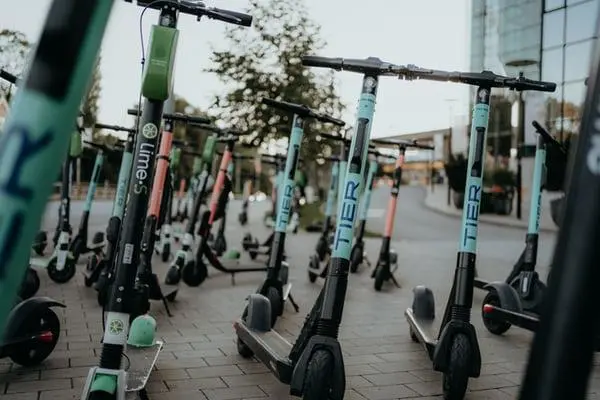Synthèse
The global market for electric scooters has experienced rapid growth, with a valuation of approximately US$33.2 billion in 2022 and an expected CAGR of 9.9% through 2030. This growth is driven by environmental concerns and the search for sustainable mobility solutions. The French market's competitive landscape includes both domestic manufacturers aiming to produce "made in France" models and foreign players dependent on international raw materials. Despite the pandemic's impact, demand for personal electric scooters surged due to a preference for individual transport and the establishment of temporary bike lanes, further propelled by public transportation strikes and rising fuel prices, which pushed consumers towards sustainable mobility alternatives.
Surging Popularity of Electric Scooters Amidst Urban Mobility Shifts
In recent times, the market for electric scooters has witnessed an upward trajectory driven by the increasing awareness and concern for the environment, and the need for sustainable urban mobility solutions. These scooters have become a desirable choice due to their maneuverability, affordability, low maintenance requirements, and particularly their compatibility with new modes of urban transportation, such as intermodality and shared services. The fervent demand for electric scooters is reflected in the growing number of users possessing their own scooters. In 2021 alone, the market saw a sale of electric scooters in the range of between 900,000 and 1,000,000 units, symbolizing a market value of approximately €300 million to €310 million. The growth rates are striking, with a volume increase of around 40% and a value surge of approximately 50% when compared to the previous year.
This indicates an evolution towards more diverse and technologically advanced models commanding higher prices. Electric scooters command a significant share within the micro-mobility market. In terms of value, they dominated with more than two-thirds of the micro-mobility device sales in the recent period. Despite the prevalence of mechanical scooters in terms of volume, electric models are quickly gaining ground with a drop to slightly over 50% from a previous dominance of 63% within a year. One catalyst driving the demand for electric scooters is the soaring fuel prices, which have been exacerbated by geopolitical events such as the conflict in Ukraine. This hike has pushed consumers towards more affordable and eco-friendly transportation alternatives. A study indicates that a significant portion of the French population views the increase in fuel prices as a direct influence in reducing the use of cars and motorcycles, and conversely, increasing the adoption of scooters and other electric mobility devices.
When considering the consumer profile, the majority of users tend to be men, with an average age hovering around late 30s. A large portion comprises active commuters leveraging the time-saving benefits of e-scooters for their daily travel. An important aspect of the market is safety consciousness among electric scooter owners compared to self-service users, as evidenced by the higher uptake of safety equipment. However, the risk of accidents remains prevalent, with around 23% of electric scooter owners experiencing some form of accident or fall over the previous year.
To sum up, the demand for electric scooters in the nation is evidently on the rise with a compound growth trajectory. As the transition towards greener.
Key Players Steering the Electric Scooter Market
As we delve into the bustling landscape of the electric scooter market, a symphony of key players emerges, each contributing to the growing chorus of urban mobility solutions. These industry front-runners are paving the way in manufacturing, technology, and sales, altering the face of personal and shared transportation.
- Xiaomi – Spearheading the Scooter Revolution Xiaomi, a global powerhouse with roots in China, has made a definitive mark on the French electric scooter landscape. Its affordable and reliable models, such as the Xiaomi Essential and Mi series, have garnered widespread appeal, making it a household name among e-scooter aficionados.
- Segway-Ninebot – Blending Innovation with Rideability : As an icon of personal transport, Segway-Ninebot has adeptly transitioned into the e-scooter domain. Renowned for quality and innovation, its Kickscooter series offers a fine balance of power and portability for adults, while models like the Zing A6 cater splendidly to the younger demographic.
- E-Twow – The Compact Mobility Maestro E-Twow stands firm in the competitive e-scooter market with its designs tailored for urban landscapes. Their compact and efficient scooters appeal to a diverse clientele looking for a seamless blend of performance and practicality on city streets.
- Kaabo – The High-Performance Pioneer Kaabo leaps ahead with its Mantis series, known for sporty performance and robust builds. Their scooters are designed to meet the demands of enthusiasts seeking a thrill without compromising on the versatility essential for navigating urban environments.
- Weebot – The Adventurous Urban Navigator Weebot is making waves with offerings like the Inoe Sweemie and Zephyr. Their e-scooters boast higher power outputs, catering to riders who desire to push the boundaries of speed and travel distances greater than the conventional commute.
- Oxelo – Decathlon's Own Urban Star Oxelo, birthed from the sports retail giant Decathlon, has positioned itself as an accessible brand. Their scooters, like the R900E and R920E, stand as testimony to Decathlon's commitment to integrating mobility into the sporting lifestyle, offering reliable scooters that balance cost and functionality. Decathlon encompasses more than its in-house brand Oxelo; it is a notable distributor of various electric scooter brands. Their expansive retail ecosystem ensures that a range of preferences and budgets are catered to.
à la compréhension de ce marché
Détail du contenu
 Informations
Informations
- Nombre de pages : 30 pages
- Format : Version digitale et PDF
- Dernière mise à jour : 13/02/2023
 Sommaire et extraits
Sommaire et extraits
1 Market overview
1.1 Definition and scope of the study
An electric scooter (or e-scooter) is a classic scooter equipped with an electric motor that allows the user to move effortlessly. It is part of what is commonly called NIEV, or New Individual Electric Vehicles, like the electric bike, the electric single wheel or the hoverboard.
The electric scooter is a mobility solution that is well suited to the new challenges of urban mobility because it can be sustainable, intermodal, light, or shared. There are two types of users of electric scooters:
- users that have their own electric scooter: a growing number.
- users of self-service scooter rental solutions: the practice has so far developed massively via this solution.
The study focuses on the first segment; but another study is available on self-service electric scooters (Businesscoot).
The sale of electric scooters worldwide is growing rapidly despite competition from free-floating scooter operators and is expected to continue to grow at a CAGR of 9.9% by 2030. The growth in the use of electric scooters is explained by the importance of environmental concern and the search for new, more sustainable means of transport.
In France, the market is also growing strongly (+42% of sales in volume between 2020 and 2021) and relies on a high level of competition between the various manufacturers and distributors. While the French market remains highly dependent on foreign raw materials, some players are trying to establish themselves and offer a "made in France" e-scooter, more ecological and more efficient. While the users are more and more numerous, the dangers of the use of this type of vehicles persist and must therefore be subjected to increasingly strict regulations.
1.2 The global market for electric scooters
The global market for electric scooters is growing rapidly. In ****, it reached approximately US$**.* billion. It is expected to grow at a CAGR of *.*% through **** [***].
Global Electric Scooter Market World, **** - ****, US$ billion Source: ****
The growth of this sector is driven by an important concern for the environment and the search ...
1.3 The French market for electric scooters is growing rapidly
The Federation of Micro-Mobility Professionals (***) market - motorized or not. These modes of travel in urban or peri-urban areas - designed for short trips - offer an alternative to thermal vehicles.
The FPMM aims at promoting micro-mobility and has made the electric scooter "the flagship product of soft and sustainable mobility". ...
1.4 The impact of the health crisis
On the demand side:
In a context of health crisis, the use of individual means of transport is favored, which stimulates the use of electric scooters. The implementation of "coronapistes" (***) has thus favored the practice:
**% think those bike paths should be maintained. **% think that they encourage the use of electric ...
2 Analysis of the demand
2.1 E-scooters are becoming more and more popular
In ****, the FPMM estimated that *.* million French people were regular users of electric scooters [***]. Among these users, we can estimate the number of users who own a scooter. Indeed, in ****, ****** new units were sold. Knowing that the life span of an electric scooter is between * and * years, we can estimate the ...
2.2 A demand divided between personal and shared scooters
A survey conducted between February and September **** by Smart Mobility Lab analyzes the use of electric scooters and MPMD in France. If the number of users has increased, the practices remain globally the same.
Preferred hours of use:
We can see that :
the preferred hours of use for MPMD owners are ...
2.3 A predominantly urban demand
The importance of demand in the city
Electric scooters are subject to regulations that encourage their growth in the city. Indeed, they are prohibited outside built-up areas except on greenways and cycle paths. In built-up areas, e-scooters must be used on cycle paths and lanes (***). If these lanes do not exist, ...
3 Market structure
3.1 Value chain and key players
A globalized value chain
Many players are involved in the value chain of electric scooters: producers of spare parts (***), manufacturers who are responsible for assembly and distributors. This creates a fragmented value chain, linking different geographical areas.
Source: ****
During the pandemic, manufacturers had difficulty obtaining the spare parts needed to manufacture ...
3.2 Battery production and import, a key element of the market
A global network
The most important part of an electric scooter is undoubtedly its battery, which represents nearly **% of the total price of the scooter [***]. For this type of vehicle, there are mainly * types of batteries:
Lithium-ion batteries. Lead batteries. Nickel batteries.
Today, the most successful batteries are the lithium ones, ...
3.3 The distribution of electric scooters
Preferred distribution channels
For the purchase of e-scooters, consumers mainly buy in hypermarkets and large specialized distributors.
Distribution of sales by distribution channel France, ****, as a % Source: ****
The major traditional distributors of electric scooters are sports retailers (***).
Finally, new players are entering the market: those of the second-hand and refurbished market. ...
4 Analysis of the offer
4.1 The different types of electric scooters
The offer of electric scooters is very diversified because of the many specificities that can be found. The models vary according to their autonomy, their speed, their weight, the charging time, the maximum authorized speed, the type of engine and wheels, the type of targeted consumer... Here is a non-exhaustive table ...
4.2 The ranges of scooters for sale
The evolution of sales price:
Taking the data from the FPMM Barometer, there has been a downward trend in the selling price of electric scooters since ****, with a CAGR of -**% through ****. The average price decline is explained by the diversification and multiplication of offers on the market. Today it seems ...
4.3 Is it profitable to own your e-scooter?
In order to compare prices pertinently, we are only interested in :
Local users (***), i.e. **% of users. Regular users (***) who are more likely to buy their own scooter, i.e. **% of local users. That is **% of self-service scooter users who are a potential target for vendors of electronic scooters to individuals ...
4.4 Electric scooters, an ecological solution?
The transport sector, a major polluter
One of the challenges in the fight against global warming is undoubtedly the transition from a thermal society to a renewable and sustainable society. In this sense, transport is the first to be affected by the transition. Indeed, transport is the first responsible for air ...
5 Regulation
5.1 Risks and accidents
EPDM owners are much more safety conscious than self-service users and are much more likely to have the appropriate safety equipment.
Safety equipment used France, ****, in percent Source: ****
Nevertheless, despite precautions, accidents are still very common. In ****, **% of owners of electric scooters and gyroroues said they had been involved in an ...
5.2 National regulation
In ****, the MPMD entered the Highway Code, with a framework of uses. The Road Safety website sets out the various rules relating to the use of electric scooters, relatively close to those applied to cyclists:
"General rules: - Users of motorized EDPs must behave carefully, both for their own safety ...
6 Positioning of the actors
6.1 Segmentation
- Xiaomi
- Ninebot
- Altermove (Mobivia Groupe)
- Decathlon Groupe
- Go Sport France
- Dott
- Tier Mobility
- Voi mobility
- Lime Neutron
- Plume Mobility
 Liste des graphiques
Liste des graphiques
- Marché mondial des trottinettes électriques
- Evolution des ventes de trottinettes électriques
- Répartition des ventes en valeur des principaux engins de la micro-mobilité
- Répartition des ventes en volume des principaux engins de la micro-mobilité
- Prix moyens mensuels de vente de détail de Gazole (1 Litre)
Toutes nos études sont disponible en ligne et en PDF
Nous vous proposons de consulter un exemple de notre travail d'étude sur un autre marché !
Dernières actualités
Entreprises citées dans cette étude
Cette étude contient un panorama complet des entreprises du marché avec les derniers chiffres et actualités de chaque entreprise :
 Choisir cette étude c'est :
Choisir cette étude c'est :
Accéder à plus de 35 heures de travail
Nos études sont le résultat de plus de 35 heures de recherches et d'analyses. Utiliser nos études vous permet de consacrer plus de temps et de valeur ajoutée à vos projets.
Profiter de 6 années d'expérience et de plus de 1500 études sectorielles déjà produites
Notre expertise nous permet de produire des études complètes dans tous les secteurs, y compris des marchés de niche ou naissants.
Notre savoir-faire et notre méthodologie nous permet de produire des études avec un rapport qualité-prix unique
Accéder à plusieurs milliers d'articles et données payantes
Businesscoot a accès à l'ensemble de la presse économique payante ainsi qu'à des bases de données exclusives pour réaliser ses études de marché (+ 30 000 articles et sources privées).
Afin d'enrichir nos études, nos analystes utilisent également des indicateurs web (semrush, trends…) pour identifier les tendances sur un marché et les stratégies des entreprises. (Consulter nos sources payantes)
Un accompagnement garanti après votre achat
Une équipe dédiée au service après-vente, pour vous garantir un niveau de satisfaction élevé. (+33) 9 70 46 55 00
Un format digital pensé pour nos utilisateurs
Vous accédez à un PDF mais aussi à une version digitale pensée pour nos clients. Cette version vous permet d’accéder aux sources, aux données au format Excel et aux graphiques. Le contenu de l'étude peut ainsi être facilement récupéré et adapté pour vos supports.
 Nos offres :
Nos offres :
the electric scooter market | France
- Quels sont les chiffres sur la taille et la croissance du marché ?
- Quels leviers tirent la croissance du marché et leur évolution ?
- Quel est le positionnement des entreprises sur la chaine de valeur ?
- Comment se différencient les entreprises du marché ?
- Données issues de plusieurs dizaines de bases de données
Pack 5 études (-15%) France
- 5 études au prix de 75,6€HT par étude à choisir parmi nos 800 titres sur le catalogue France pendant 12 mois
- Conservez -15% sur les études supplémentaires achetées
- Choisissez le remboursement des crédits non consommés au terme des 12 mois (durée du pack)
Consultez les conditions du pack et de remboursement des crédits non consommés.
- 01/03/2024 - Mise à jour des données financières de l'entreprise Go Sport France
- 06/02/2024 - Ajout des informations de l'entreprise Plume Mobility
- 06/02/2024 - Ajout des informations de l'entreprise Lime Neutron
- 06/02/2024 - Ajout des informations de l'entreprise Voi mobility
- 06/02/2024 - Ajout des informations de l'entreprise Tier Mobility
- 06/02/2024 - Ajout des informations de l'entreprise Dott
- 06/02/2024 - Ajout des informations de l'entreprise Lime Micromobility
- 04/11/2023 - Mise à jour des données financières de l'entreprise Go Sport France
- 03/08/2023 - Mise à jour des données financières de l'entreprise Go Sport France
- 02/05/2023 - Mise à jour des données financières de l'entreprise Go Sport France
- 06/04/2023 - Ajout des informations de l'entreprise 677 le marché des trottinettes électriques en France
- 21/02/2023 - Mise à jour des données financières de l'entreprise Panasonic
- 21/02/2023 - Mise à jour des données financières de l'entreprise BYD
- 13/02/2023 - Mise à jour des visuels
- 13/02/2023 - Ajout des informations de l'entreprise Panasonic
- 13/02/2023 - Ajout des informations de l'entreprise Sanyo Electric (Panasonic Groupe)
- 13/02/2023 - Ajout des informations de l'entreprise BYD
- 13/02/2023 - Ajout des informations de l'entreprise CATL
- 13/02/2023 - Ajout des informations de l'entreprise Fnac Darty
- 13/02/2023 - Ajout des informations de l'entreprise Go Sport France
- 13/02/2023 - Ajout des informations de l'entreprise Decathlon Groupe
- 13/02/2023 - L'étude a été complètement mise à jour par un analyste Businesscoot. En plus de cette revue complète, des informations sur la production de batterie, les acteurs locaux et les accidents ont été ajoutées. La partie sur les différents types de trottinettes électriques et leur prix a aussi été développée.





 Decathlon : tous les chiffres des performances 2023 - 05/04/2024
Decathlon : tous les chiffres des performances 2023 - 05/04/2024
 Fusion Tier-Dott : Nécessité pour les rivaux des e-trottinettes et vélos - 11/01/2024
Fusion Tier-Dott : Nécessité pour les rivaux des e-trottinettes et vélos - 11/01/2024
 Micromobilité : Fusion en vue entre Tier et Dott - 11/01/2024
Micromobilité : Fusion en vue entre Tier et Dott - 11/01/2024
 Plume Mobility lance l'industrialisation de sa trottinette électrique en France - 22/12/2023
Plume Mobility lance l'industrialisation de sa trottinette électrique en France - 22/12/2023


















